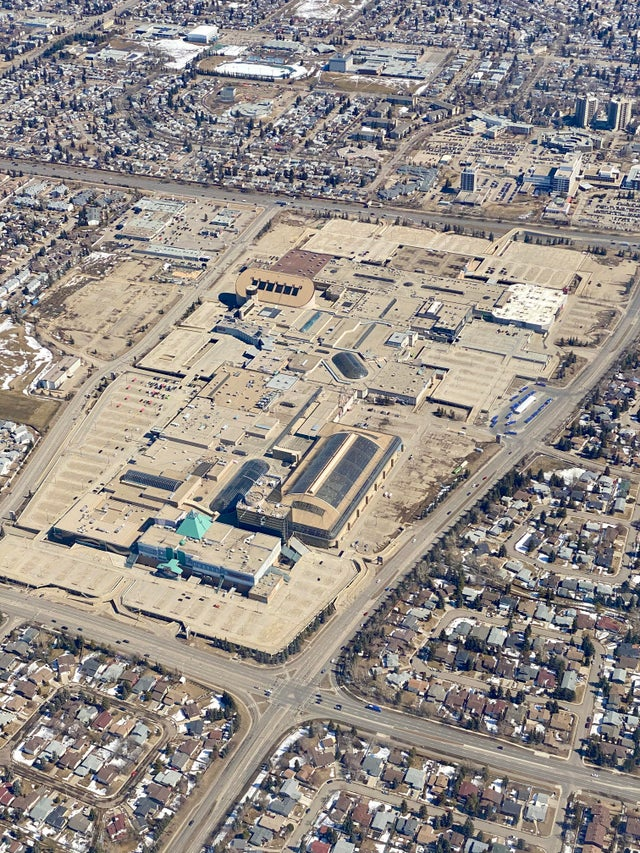No More Minimums: How parking regulations have shaped the city
/Blog post written By Jonathan Milne
Living in the suburbs, I don't think about parking very often. When I do, I’m usually driving laps around rows of vehicles, cursing under my breath as I hunt for an empty space (one that I won’t have to pay for, ideally). It’s easy to ignore the sheer amount of parking in the city, as long as I can get some of my own. If I do notice it, all of that asphalt is probably just a result of our free-market, consumer-driven North American lifestyles, right?
The West Edmonton Mall parking lot sitting empty during the COVID-19 shutdown https://dailyhive.com/calgary/photo-empty-west-edmonton-mall
Although it may not be obvious, much of the parking we see in Edmonton and other cities was built to meet minimum onsite parking requirements implemented by local governments. Most of these policies were incorporated in the mid-20th century when cities were experiencing rapid growth and attempting to adapt to the rise of the automobile. Edmonton introduced parking minimums in 1964 and according to an ever-growing amount of research, these rules have had a significant, often negative impact on the livability and productivity of the city.
For businesses and shopping centres, parking minimums were usually intended to provide enough parking during peak demand. This means that in theory, if a developer provided the minimum required number of spaces, customers would be able to find parking even on the busiest days. However, after decades with these rules in place, many municipalities including Edmonton find themselves with an overabundance of onsite parking. For instance, in the City of Edmonton’s Comprehensive Parking Study (2019), the observed commercial and residential sites had a “maximum observed usage” of 39% and 64%, respectively. On an average day, thousands of parking spaces are left open on these sites across the city.
Parking in downtown Edmonton http://spacing.ca/edmonton/2013/10/16/parking-dtyeg/
Parking comes at a high cost, in terms of both the land it uses and the money needed to build and maintain it. Keeping spaces that will be empty for most of the time wouldn’t be in property owners’ best financial interests. Surprisingly, if it was left to the market to decide how much parking should be built, many North American cities would probably have less parking than they do today.
The price of street parking is another factor to consider. According to the urban planning scholar Donald Shoup, 99 percent of all automobile trips in the United States end with free parking. In most cities the cost of street parking is likely cheaper than it should be, given the high demand for those spaces. Underpriced curb parking means there will be fewer available spots, which leads to more drivers cruising around the block while they wait for one to open up. A study by Shoup of Westwood Village, a shopping district in Los Angeles, found that on an average day drivers in the area traveled a combined distance of over 5600 km searching for parking- greater than the distance across the United States.
Shoup suggests two parking solutions for cities: charge fair prices for street parking, and get rid of onsite parking minimums. The first would make it more expensive to park; the second would make parking less available. As drivers, this isn’t something we like to hear, but it’s important to remember that even when parking is free, we still have to pay for it- just in different, less obvious ways. This cost is included in the products we buy and the rent we pay to the businesses and property owners who are required to provide parking to us. Pedestrians, cyclists, and transit users pay when their taxes go towards auto infrastructure that inhibits their own modes of transportation, and leads to a lack of people-friendly streets. Perhaps most importantly, the environmental cost is borne by city residents who suffer from the effects of air pollution, and people around the world who are experiencing the effects of climate change.
In June, Edmonton city council began to address these issues by voting to remove parking minimums, making Edmonton the first major city in Canada to do so. This aligns with the vision outlined in the latest draft of Edmonton’s City Plan, which emphasizes the importance of building around a “network of nodes and corridors” accessible by public transit, and not limiting residents to a single mode of transportation. The city’s Energy Transition Strategy also suggested removing parking minimums for new developments. Council has created a plan to reduce greenhouse gas emissions to 50% below 2005 levels by 2030, so it’s encouraging to see these steps being taken.
It will take years for the effects of removing parking minimums to become visible in our city. Today, however, developers in Edmonton will no longer be forced to provide more parking than they need. The next time you find yourself cruising for parking- perhaps in the world’s largest parking lot at West Edmonton Mall- take a moment to look around at all of those spaces and ask yourself: how much of this do we actually need?



